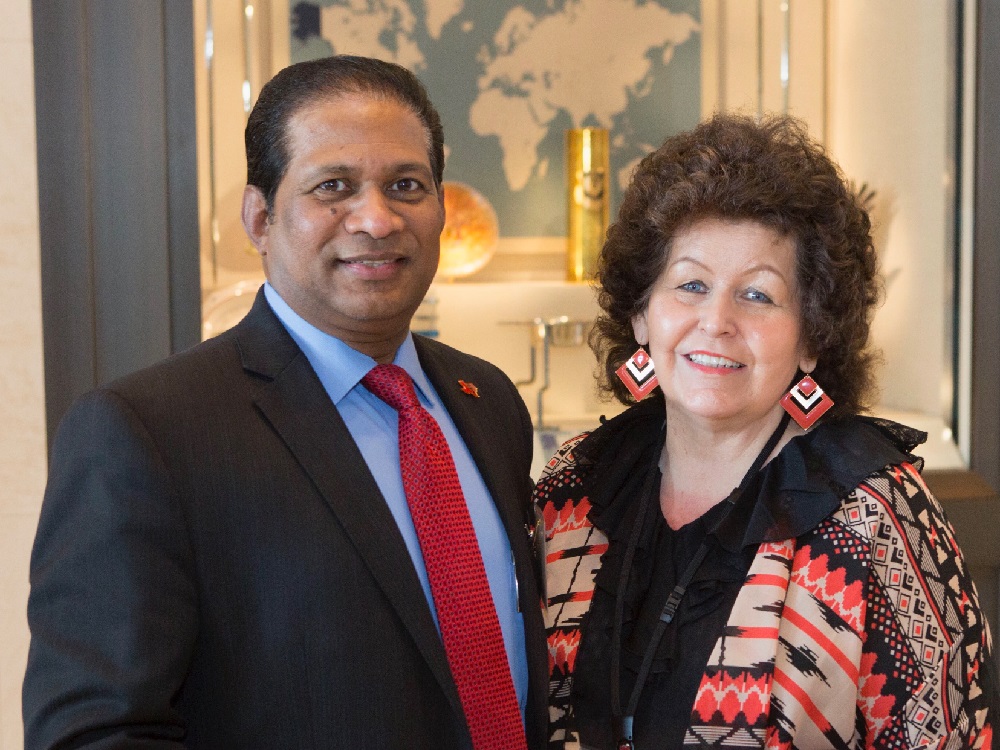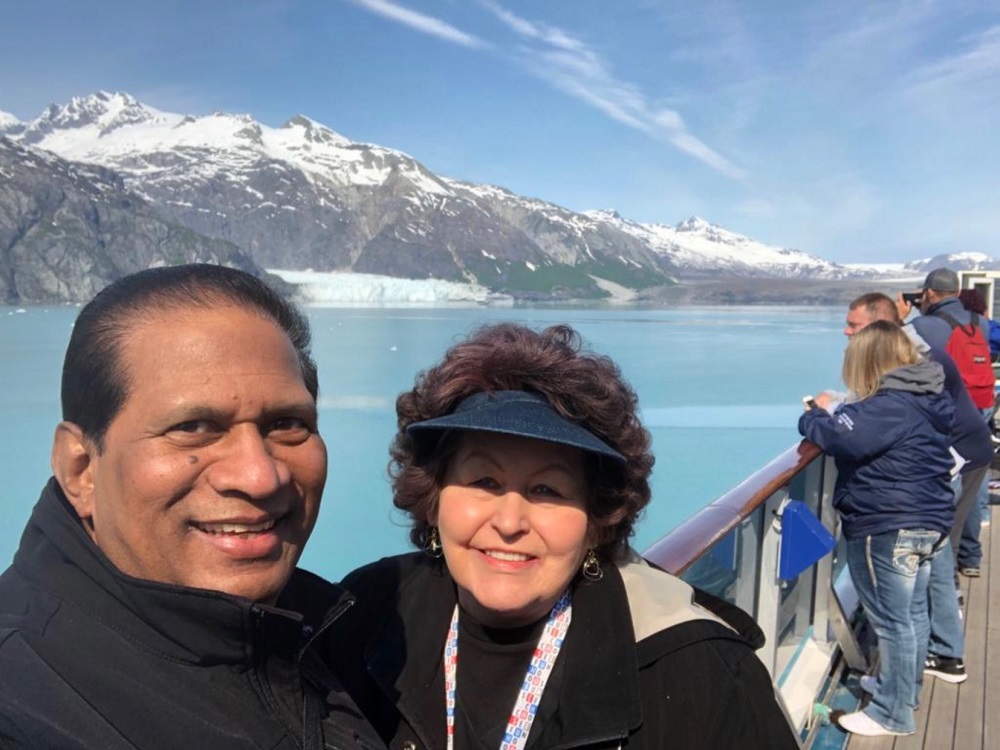Alumni Focus: Sam Segran
Chief Information Officer and Vice President for Information Technology
Texas Tech has a motto, “From here, it's possible.” Sam Segran, Texas Tech's Chief Information Officer and Vice President for Information Technology has embodied that philosophy throughout his life and career. It's no surprise that he found his way to Texas Tech University. Segran describes himself as a nontraditional student when he arrived at Texas Tech in the 1980s to pursue a bachelor degree in Management Information Systems (MIS) and then a master degree in Business Administration. In looking at his career path, one would agree that it is anything but traditional. A native of Malaysia, Segran has worked in Information Technology (IT) at Texas Tech for more than 30 years. In his current position, Segran is responsible for all IT operations and management for the university. Under his guidance, this department has acquired a national reputation as an outstanding university information technology division.
Tell us about growing up in Malaysia and how you got interested in information technology.
“I grew up in Malaysia which is a multiracial country. My friends were from all denominations – Hindus, Christians, Muslims and Buddhists. That's how we grew up. Even now my family is blended with different races and religions.”
“Malaysia was a British Commonwealth country, so our education was British based. Since my dad was a teacher, I grew up in an educational environment. After completing my Cambridge O and A levels, I left Malaysia with the promise of a job in Singapore and the equivalent of US$30 in my pocket. I trained as a commercial pilot for Singapore Airlines, was initially certified for small planes and eventually type-rated for Boeing 747s. They also trained us as flight attendants. When our flight training and subsequent fleet deployment was delayed, we were given an opportunity to take a sabbatical to do further studies.”
What brought you to Texas Tech to pursue a degree in MIS?

“I came to Tech with a dozen fellow pilots. As nontraditional students, we did not come through the normal route as an international student. We came as working adults that took time off to do further studies. Most of us ended up in the engineering or computing areas. I started in computer science. Not much was known about computing at that time – it was just emerging. By switching from Computer Science to MIS and taking 17-19 hours a semester as well as 6-12 hours in the summer, I was able to finish a four-year degree program in two years and nine months. Not just me but my friends as well. Most of the original twelve of us still remain in contact. Four went back to Singapore Airlines to fly and the rest of us scattered all over the world. I'm the only one who stayed in Lubbock. I met my wife, Jamie, here and she is one of the main reasons I stayed. We got married 32+ years ago. Tech made it possible for me to work here and complete my MBA. My first job was in the athletic dining hall. I think I was the first non-American supervisor there. Then after a couple of years, I joined Academic Computing Services (ACS) to work at the Computing Help Desk. At that time Tech was in a transition from the IBM mainframe to VAX/VMS for academic users while the IBM mainframe was used for both administrative and academic computing. I learned both the IBM mainframe and the VAX/VMS systems, taught introductory computing classes and then went into the client/server computing and numerous other computing areas. Also, during this time, the Advanced Technology Learning Center (ATLC) was built as a home for ACS in the west basement of the Library building. Prior to that, ACS had two IT help desks – in Engineering Center and in Business Administration, and I worked at both of them; so, coupled with a few other departmental computing operations, that's the early computing operations at Texas Tech.”
Tell us how you were able to grow the Information Technology division to where it is today?
“I started managing the ATLC in 1987, and in 1990s, a couple of ACS staff and I put Tech on the web at www.ttu.edu and TTU System at www.texastech.edu. Then in 2000, Chancellor Montford appointed a team of four employees, including me, to review, redesign and restructure information technology across the Texas Tech system. We basically worked for about a year analyzing the emerging computing landscape and industry, while also investigating Texas Tech's growing computing needs. We collected feedback from several hundreds of individuals from across the Texas Tech System, then submitted a proposal to the Chancellor, Presidents, and Board of Regents to restructure Information Technology operations in order to position Texas Tech to be successful. We accomplished this long before most universities across the nation. This is the reason we are so far ahead of other universities today because we started so long ago.” Segran states he continues to work closely with the remaining member of the original team, Kay Rhodes, CIO at TTU System. “IT is a challenging field in a complex environment where the technology is constantly changing. It is so much easier when you can work in collaboration with other people, and that's what we've been building for many years. It's not just us. We work with others across the campus, building bridges with deans, vice presidents, and staff members in other colleges and departments. We have spent a lot of time building those bridges and I think that it's one of the things that I have seen Texas Tech do better than a lot of other universities. Nationally, we are well known in this environment. I serve on several national and regional boards and committees and have the opportunity to present at different conferences and groups so people hear about how we do things and they are puzzled about how all the entities at Texas Tech work so well together. That is not very common in other university systems.”
“We have also been very careful about managing our technology environment in a very strategic and prudent manner, so we don't waste resources.” Segran states that they involve the major stakeholders when they choose new technology. “But once we do that, we work hard to make sure that the technology is going to meet the needs of the people that did not select it as well, not just those who did.”
How many employees are in your division?
“Full-time we have approximately 130 employees and part-time we have students that come and go so it fluctuates from about 80 to a couple hundred depending on the time of year. We have really good people and we invest a lot in our people. IT staff members are very marketable. They can easily go to other industries, so one thing we have worked hard at is trying to keep people happy." Segran believes every member of the team is important. “We try to build a family environment. We work hard, but we also come together and celebrate with our key partners at the end of the year on our year-long activities and accomplishments. We have experienced team members at different levels. Everyone who works here is dedicated in making Tech successful. We are also committed to investing in them.”
What are your future goals for information technology?
“More and more, it's really about making sure that as fast as technology changes, we only apply what makes sense for Texas Tech's needs. Making changes for the sake of change is not going to necessarily help. Many times, we're not selecting the technology. It's the faculty, staff or students who are asking for different types of technology. In fact, one of the things we started doing a couple of years ago was giving awards for outstanding use of technology and innovation to support institutional priorities by other departments, not central IT.”
“So when you ask what my vision is, my vision is that technology is best used to support the goals of the institution, and not for the sake of deploying new technology. Technology evolution should also be as seamless as possible. We scan the emerging technology horizon constantly and look for opportunities to benefit Texas Tech. The university should not need to wait on me or my staff. We should already be there when they need it. That's been our philosophy. We should always be trying to stay ahead, anticipating issues, and putting the infrastructures in place so that the university mission goes on and the university business goes on.”
Segran believes that cyber security awareness should go beyond the campus of Texas Tech. In 2004, his division launched a cybersecurity awareness campaign for Texas Tech and the Lubbock area community. The IT division also participates in community outreach through cybersecurity awareness presentations for organizations such as the Osher Lifelong Learning Institute, Lubbock Chamber of Commerce, schools, and many others. Segran was a member of the Texas Cybersecurity, Education, and Economic Development Council that was created by the Texas Legislature. This council generated a report that led to several bills being passed by the Texas Legislature, including one that makes a state agency, Department of Information Resources (DIR), responsible for providing cybersecurity awareness information to all 26 million people in Texas. “These are the positive things we are able to do behind the scene, where we go beyond Texas Tech and the whole state benefits in terms of how we do things. So, there's a lot more that goes on than just within Texas Tech. We can have a great positive impact.” He is still a member of the Council in its current form, the Texas Cybersecurity Council.
What advice would you give to international students who would like to study at Texas Tech?
“Like anything else, you need to ask if studying at Texas Tech is in line with what you want to do. The mistake some people make is that they think you just have to get somewhere. But the somewhere may not be the right place. They need to do a little bit of research and look at the programs that Tech is doing well in and make sure it aligns with what they are looking for.”

Segran also advises that international students should come here with an open mind, learn local customs and don't just stay in their cliques. Growing up in Malaysia and traveling internationally with his job at the airline gave Segran the opportunity to meet people from all over the world. He and his wife still travel every chance they get. “I think the biggest mistake that international students may make is not initiating new friendships. Although it's good to be with your friends and your community, don't just stay there. You need to venture out just a little. Meeting different people gives you new information and a different perspective.” His first encounters with Americans and other expatriates were on the beaches in Malaysia. “The first Americans that I met were hippies on the beach which gave me one perspective of Americans. Another American I met was a Peace Corps history professor. And he was totally different than the Americans I met on the beach. Other Americans I met were the GIs coming in for R and R from Vietnam. My flight instructors were from Singapore, United Kingdom, Australia and New Zealand. I think that international students need to understand that the one or two people that you meet, or the others portrayed in movies don't represent all Americans. America is a big place, so they need to keep an open mind about that. It's nice to see what Tech is doing through the study abroad program and the international program. Students who study abroad and international students who study at Texas Tech help build the friendship bridges for the future.”
International Affairs
-
Address
601 Indiana Avenue, Lubbock, TX 79409-5004 -
Phone
806.742.3667 -
Email
oia.reception@ttu.edu
